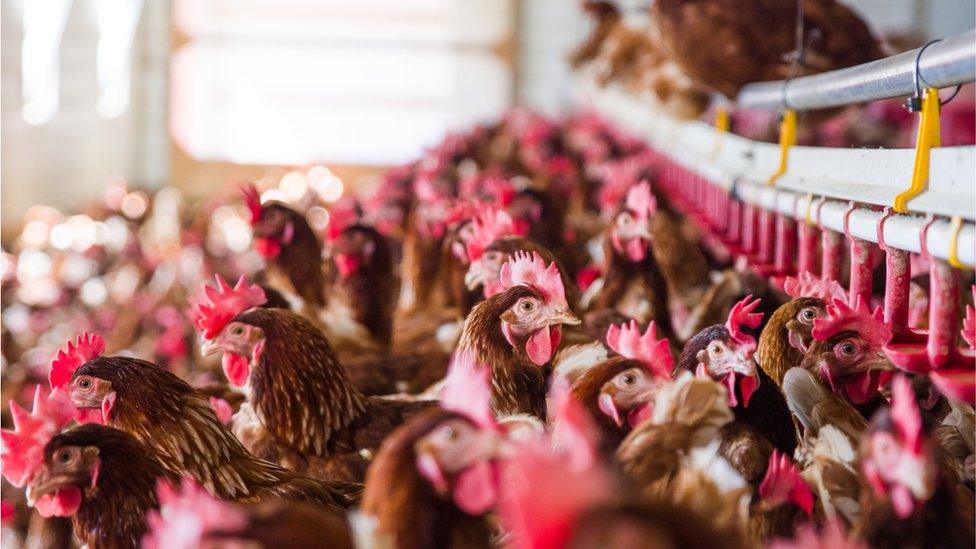NI Agriculture: Poultry numbers on farms fall according to latest census
- Published

Poultry numbers on NI farms deceased by 16% in 2022, according to the latest agricultural census
The number of poultry on Northern Ireland farms decreased by 16% in 2022, according to the agricultural census.
The Department of Agriculture, Environment and Rural Affairs (DAERA) said economic and animal health factors were behind the change.
The number of cattle remained almost steady, while pigs and sheep increased by just over 3%.
The figures show the overall area farmed in Northern Ireland has risen to just over 1m hectares.
That figure does not include common land - land over which other people have certain rights, usually grazing or collecting wood for fuel.
The survey data was collected on 1 June 2022,, external with 17,223 questionnaires completed.
On that day, 20.6 million poultry were recorded, compared to 24.5 million in June 2021.
'Rise in costs for energy and feed'
The number of laying birds increased by 6%, after a fall last year.
But broilers, or birds destined for human consumption, decreased by 25%.

Latest figures show the overall area farmed in Northern Ireland has risen to just over 1m hectares
A DAERA spokesperson said that figure was largely the cause of the fall in overall poultry numbers.
"It is important to note that figures in the agricultural census report measure the number of birds on farms on a specific date," they continued.
"Over the course of the year poultry numbers on farms may vary.
"Avian influenza has been signalled as having had a disruptive impact on poultry production in 2022.
"Other factors include well-documented cost increases for inputs such as energy and feed."
The total area of crops grown in Northern Ireland was 48,139 hectares, an increase of 4% from 2021.
Cereals increased by 7%, wheat by 12% and oats by 5%.
Winter and spring barley increased by 8% and 4% respectively.

Analysis: Not surprising that poultry numbers are lower due to increased costs
Poultry generally need a lot of heat and feed, and with the massive increases in those costs over the last year it is hardly surprising that numbers are lower.
But this is just a snapshot of a single day - almost six million birds are still processed for consumption every week in Northern Ireland. And the increase in laying birds after the decrease last year shows this is still an attractive industry.
The bigger question is, where are the livestock reductions that the climate change committee said will be needed to meet our legally-binding climate targets?
With methane-producing ruminants like cows and sheep on the rise, however slowly, some environmentalists will ask if our highest-emitting sector is taking its fair share of the fight against climate change, or just trying to maintain business as usual.
Farmers will point to the steps agriculture is taking to reduce environmental impact by improving efficiency - reducing the amount of fertiliser needed by testing soils, developing better and faster-growing animals that can go to slaughter more quickly, and changing traditional practices, like how slurry is spread and used.
With these results coming in the same week as the committee's Northern Ireland update, it is a something of a reminder of the difficult balance to be struck between saving the world and feeding it.

Related topics
- Published16 December 2021
